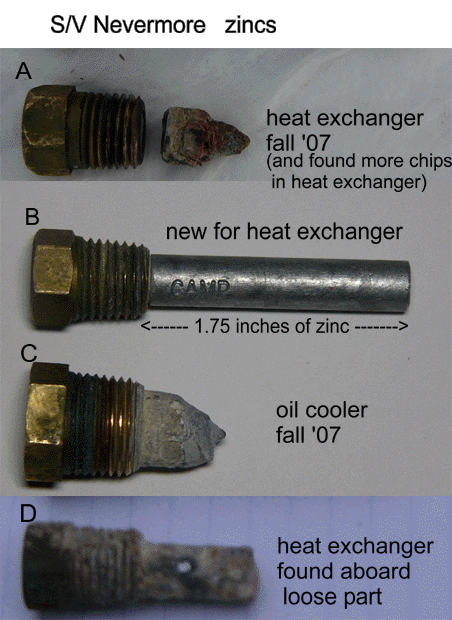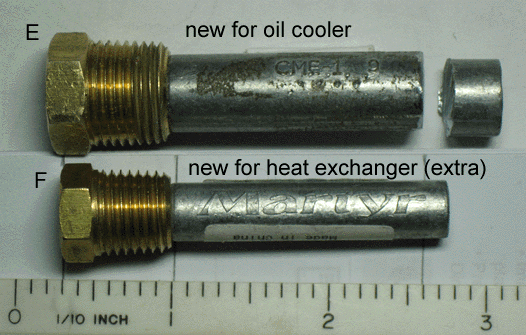Difference between revisions of "Engine zincs replace 2007"
From MITNA
m (minor formatting) |
m (boiler-plate text) |
||
| Line 57: | Line 57: | ||
'''COMMENTS and THOUGHTS''' | '''COMMENTS and THOUGHTS''' | ||
| + | |||
| + | * Glossary: | ||
| + | ** HE or Heat Exchanger : raw seawater is pumped through an outer cylinder at the same time that fresh engine cooling water is circulated through pipes in the cylinder; heat is transferred from the fresh water to the seawater and removed from the engine. | ||
| + | ** OC or Oil Cooler : raw seawater is pumped through an outer cylinder (the same water the HE uses), and cools the engine oil which is circulated -- probably via small pipes -- inside the cylinder; the engine oil is cooled. | ||
| + | ** zinc, or pencil-zinc : well, start by looking at the pictures B, E and F; consists of a threaded xxx and a pencil of zinc which (often) screws into it; when electric currents flow in the salt water in which the pencil is emmersed, the zinc, being the least-noble metal we expect to find around the boat, will become a sacrificial anode, and will be eaten away by galvanic corrosion rather than the other boat parts. | ||
Revision as of 18:48, 30 January 2008
There are two pencil zincs on Nevermore's engine. Both are shown in the Westerbeke engine Parts List "Cooling System" figure on page 220 (and repeated on page 222.) This figure is also on the [web], as is the parts item list that is on our hardcopy pages 221 and 223.
The heat exchanger is REF number 23 (P/N 15799), and the oil cooler is REF #32 (P/N 11518).
Both pencil zincs are shown as REF #33 (P/N 11885). This is a workable part for the heat exchanger, but not for the oil cooler, which requires a fatter and possibly shorter pencil, with a larger screw thread radius.
PHOTO DESCRIPTIONS
- A: Old pencil zinc removed from the heat exchanger (the heat exchanger moves sea water over cooling tubes which have circulating fresh water, which in turn cools the engine.)
- The little chunk was found inside the heat exchanger, along with several very small (like sand) pieces of zinc (and/or possibly actual sand?)
- B: New pencil zinc installed Fall '07; we found two of these aboard Nevermore in the box of new spare parts.
- C: Old pencil zinc removed from the oil cooler (the oil cooler moves sea water over cooling tubes which have circulating engine oil, the same oil used to lubricate and cool the engine.)
- D: Old pencil zinc found aboard Nevermore; it's the same size as (B), so we assume it was removed by previous owner, but at unknown (to us) time.
- E: New pencil zinc we bought, ready to be installed in the oil cooler (Jan08); we had to cut down its length (we discuss this below, but note that its original zinc part is longer than the heat exchanger zinc, whereas the oil cooler is smaller diameter than the heat exchanger.)
- F: Another new pencil zinc for the heat exchanger, presented here to show the different size of item E zinc. We bought it (West Marine) to compare to the units we found aboard (see item B.)
COMMENTS and THOUGHTS
- Glossary:
- HE or Heat Exchanger : raw seawater is pumped through an outer cylinder at the same time that fresh engine cooling water is circulated through pipes in the cylinder; heat is transferred from the fresh water to the seawater and removed from the engine.
- OC or Oil Cooler : raw seawater is pumped through an outer cylinder (the same water the HE uses), and cools the engine oil which is circulated -- probably via small pipes -- inside the cylinder; the engine oil is cooled.
- zinc, or pencil-zinc : well, start by looking at the pictures B, E and F; consists of a threaded xxx and a pencil of zinc which (often) screws into it; when electric currents flow in the salt water in which the pencil is emmersed, the zinc, being the least-noble metal we expect to find around the boat, will become a sacrificial anode, and will be eaten away by galvanic corrosion rather than the other boat parts.

